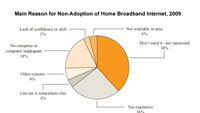Lack of interest cited as biggest reason U.S. households don’t subscribe to broadband Internet service, according to government report

A comprehensive government report released Nov. 4 identifies lack of interest among nonbroadband Internet households as the top reason they have decided not to subscribe to high-speed Internet service in their homes.
The 68-page report, “Exploring the Digital Nation: Home Broadband Internet Adoption in the United States,” was prepared by the Economic and Statistics Administration and the U.S. Department of Commerce’s National Telecommunications and Information Administration (NTIA).
Drawing on a survey of 54,000 homes conducted in October 2009 as part of the Census Bureau’s Current Population Survey Internet use supplement, the new report plunges into the depths of the broadband Internet connectivity issue — one of great importance to the TV broadcast industry, which the FCC has identified as the source of 120MHz of bandwidth to meet future wireless broadband Internet demand.
To determine the reasons why those without home broadband have chosen not to subscribe, the report examines three groups: households that don’t use the Internet; those that use a dial-up Internet service; and those that don’t use the Internet at home but use it elsewhere. When the three groups are taken together, the reasons given include:
- Don’t need it/not interested — 38 percent
- Too expensive — 26 percent
- No computer/computer inadequate — 18 percent
- Can use it somewhere else — 4 percent
- Not available in area — 4 percent
- Lack of confidence or skill — 3 percent
- Other reasons — 6 percent
Comparing each group to the whole revealed several differences. For instance, among Internet non-users, 47 percent said they didn’t need broadband and were not interested; 19 percent said cost was the main factor; and 22 percent said they did not have a computer or their computer was inadequate.
The most frequently mentioned reason among those who used the Internet outside of the home was cost. Forty percent said the main impediment was the expense. Seventeen percent of this group cited a lack of interest or need for broadband Internet service, and 15 percent said they had the ability to use the Internet some place other than their home.
Like those with access to the Internet elsewhere, the biggest reason among those in households with dial-up service for not subscribing to broadband was expense. Forty-one percent said the service was too expensive; 27 percent said they don’t need or were not interested in broadband; and 20 percent said it was not available in their area.
Get the TV Tech Newsletter
The professional video industry's #1 source for news, trends and product and tech information. Sign up below.
The report also found that 70 percent of U.S. households accessed the Internet in 2009, and the majority of them used broadband service at home. Gaps in broadband Internet usage were evident between richer and poorer households, racial groups, urban and rural, and those with disabilities versus the rest of the population.
Phil Kurz is a contributing editor to TV Tech. He has written about TV and video technology for more than 30 years and served as editor of three leading industry magazines. He earned a Bachelor of Journalism and a Master’s Degree in Journalism from the University of Missouri-Columbia School of Journalism.

